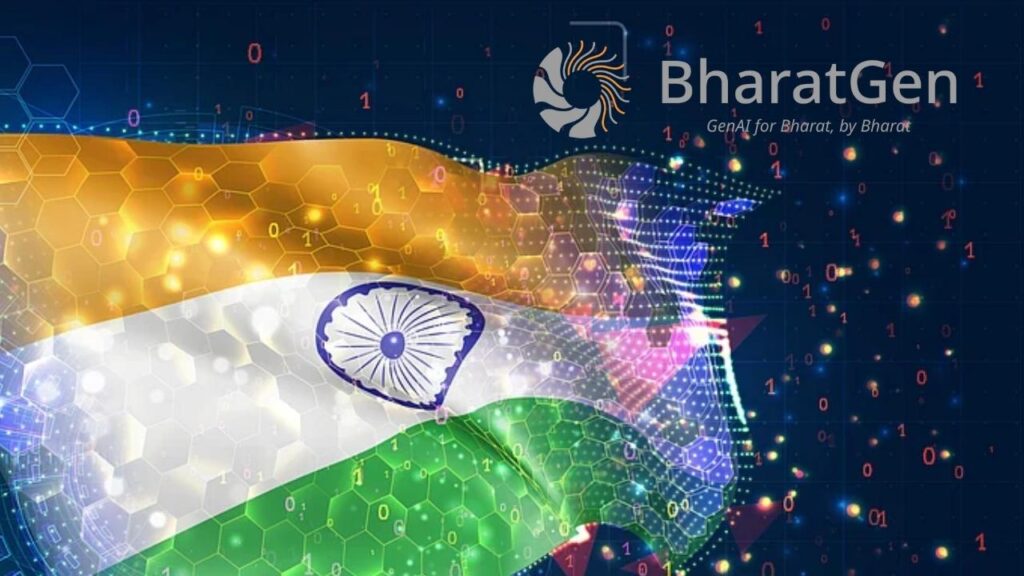India Launches BharatGen AI Model: India has officially launched its first indigenously developed multimodal AI model, known as BharatGen, aiming to revolutionize multilingual innovation across the country. This announcement was made at the BharatGen Summit 2025, an event that brought together top researchers, government officials, and AI industry leaders. BharatGen is being hailed as a landmark initiative in India’s digital transformation journey, designed to support 22 Indian languages with capabilities spanning text, speech, and image processing.

Artificial Intelligence (AI) is transforming industries globally, but India’s linguistic diversity presents unique challenges and opportunities. BharatGen aims to bridge these gaps by creating a tool that is not only technologically advanced but also culturally and linguistically inclusive.
Table of Contents
India Launches BharatGen AI Model
| Feature | Description |
|---|---|
| Model Type | Multimodal AI Large Language Model (LLM) |
| Supported Languages | 22 Indian languages including Hindi, Tamil, Bengali, Kannada, and more |
| Modalities | Text, Speech, Image |
| Developed By | TIH Foundation for IoT and IoE at IIT Bombay |
| Funded By | National Mission on Interdisciplinary Cyber-Physical Systems (NM-ICPS) |
| Governing Body | Department of Science and Technology (DST), Government of India |
| Target Applications | Healthcare, Education, Agriculture, E-Governance, Translation |
| Official Website | DST India |
BharatGen represents a historic leap in India’s AI development landscape. It embodies the country’s aspiration to create AI that is not only technologically advanced but also culturally relevant and linguistically inclusive. By enabling seamless interaction in 22 Indian languages across multiple media, BharatGen promises to bridge the digital divide and empower millions of Indians.
Its application in healthcare, agriculture, education, and governance signals a future where AI is a true partner in progress, fostering innovation while respecting India’s rich diversity. BharatGen is more than a model—it is a national mission to democratize AI for all.
What Is BharatGen and How Does It Work?
BharatGen is a multimodal Large Language Model (LLM), which means it can understand and generate not only text but also speech and images. This makes it a versatile AI platform capable of handling a broad range of tasks. Unlike many existing AI models that focus primarily on English and a few global languages, BharatGen has been specifically trained to support 22 Indian languages, covering the majority of India’s linguistic landscape.
The Technology Behind BharatGen
The development of BharatGen relied on cutting-edge open-source AI frameworks such as transformers and diffusion models, which are state-of-the-art methods in AI research. The model was trained on a rich and diverse dataset comprising:
- Government and public domain documents
- Regional newspapers and journals
- Audiobooks, podcasts, and spoken language corpora
- Open-source image and video libraries relevant to Indian culture and contexts
This broad and diverse training data enables BharatGen to understand nuances and context specific to Indian languages, dialects, and cultures — a critical factor missing in many international AI models.
The model also uses advanced multilingual embeddings, which allow it to transfer learning across languages. For example, knowledge gained from Hindi data can help improve its performance in less-resourced languages like Maithili or Tulu.
Real-Life Applications of BharatGen

The true strength of BharatGen lies in its practical applications that address real challenges faced by millions of Indians daily. Here are some promising use cases:
Healthcare
In rural India, access to medical professionals is limited. BharatGen-powered applications can provide voice-based diagnostic assistance in local languages, allowing healthcare workers or patients to interact naturally and get instant advice. For example, a nurse in Odisha can ask the AI about dosage instructions in Odia, or a farmer experiencing health issues can get symptom-related guidance in Telugu.
Beyond first aid, BharatGen can assist in translating medical records, summarizing complex documents, and even generating personalized health tips, improving healthcare accessibility and outcomes.
Agriculture
Agriculture remains the livelihood for over 50% of India’s population. Farmers often face barriers when seeking timely advice on crop management, pest control, or weather predictions. With BharatGen, farmers can speak or type questions in languages like Punjabi or Marathi and receive immediate, actionable responses tailored to their specific region and crops.
Such AI-enabled assistance can reduce crop losses and enhance productivity. For example, a mango farmer in Maharashtra can ask about disease symptoms in Marathi and get recommendations on treatment, fertilizer use, or harvesting time.
Education
India’s education sector benefits significantly from BharatGen’s capabilities. The AI can help convert textbooks into audio lessons in various regional languages, aiding children in rural areas who may be visually impaired or lack reading proficiency.
Furthermore, BharatGen can be integrated into online learning platforms to provide real-time translation and content adaptation. This can democratize access to global educational resources, enabling students from diverse backgrounds to learn in their mother tongue.
Government Services
E-Governance initiatives aim to make government services transparent and accessible. BharatGen enhances this by powering multilingual chatbots and voice assistants on public portals, helping citizens understand complex procedures, file applications, and access benefits — all in their preferred language.
This reduces the digital divide and ensures that even non-English speakers can interact confidently with government services, promoting inclusivity and empowerment.
Why Multilingual AI Matters for India
India is a vast and linguistically diverse nation, with more than 1.4 billion people and over 19,500 dialects. Despite this diversity, most existing AI models cater primarily to English, limiting their usefulness for many Indians.
Key Statistics
- India officially recognizes 22 scheduled languages, spoken by over 95% of the population.
- Only around 10% of Indians are fluent in English.
- Approximately 70% of rural internet users prefer to communicate in local languages
- Literacy in Indian languages is crucial for digital inclusion.
By supporting this linguistic diversity, BharatGen enables digital inclusivity, ensuring government schemes, health information, education, and entrepreneurship tools reach the masses in their own language.
The BharatGen Ecosystem and Collaboration
BharatGen is much more than a model — it’s a step towards building a vibrant AI innovation ecosystem in India.
Academic and Industry Partnerships
The project is led by the TIH Foundation for IoT and IoE at IIT Bombay, with support from other premier institutions like IITs and IIITs. It fosters collaboration with startups, tech companies, and research labs to accelerate development and deployment.
Government Support
BharatGen is funded under the National Mission on Interdisciplinary Cyber-Physical Systems (NM-ICPS) and supervised by the Department of Science and Technology (DST), which emphasizes ethical AI development aligned with India’s policy frameworks.
Community Engagement
To foster innovation, the government is organizing:
- Hackathons and AI challenges that invite students, researchers, and developers to create applications using BharatGen.
- Fellowship and incubation programs in Tier 2 and Tier 3 cities to promote decentralized AI entrepreneurship.
- Partnerships with NGOs and community groups to extend AI benefits to underserved populations.
BharatGen and the Digital India Vision
The Digital India mission aims to transform India into a digitally empowered society and knowledge economy. BharatGen directly contributes to this vision by:
- Promoting language inclusivity, thereby expanding access to digital services.
- Encouraging AI-based entrepreneurship, fostering economic growth and innovation.
- Improving public service delivery through intelligent, accessible platforms.
It also complements initiatives like PM Gati Shakti (focused on infrastructure) and Digital Saksharta Abhiyan (DISHA), which promote digital literacy among rural populations.
Quantum Computing Milestone Achieved, Immediately Challenged by Supercomputer
South East Queensland Positioned as Global Hub for Quantum Computing Revolution
Next-Generation EV Battery Design Uses Less Lithium While Delivering Strong Performance
FAQs About India Launches BharatGen AI Model
Who can use BharatGen?
BharatGen is designed for a broad user base, including:
- Developers and AI researchers
- Startups and entrepreneurs
- Educational institutions
- Government agencies
The model will be accessible via APIs and SDKs to facilitate integration into various applications.
Is BharatGen free to use?
Initial access is free for research and educational institutions. Commercial licensing will be introduced with tiered pricing to support startups and enterprises while ensuring wide accessibility.
Where can I access BharatGen?
You can access BharatGen through the official DST website and IIT Bombay’s AI innovation portals once the public API is launched.
Can BharatGen be used offline?
A lightweight version designed for offline use, particularly in rural areas with limited internet connectivity, is under development. This will leverage edge computing to provide AI capabilities without continuous online access.
How is BharatGen different from ChatGPT or other global LLMs?
While models like ChatGPT support multiple languages, they do not specialize in the regional nuances and cultural contexts of Indian languages. BharatGen is tailored specifically for India’s multilingual landscape and includes speech and image modalities, which are not yet fully supported in many international LLMs.



















